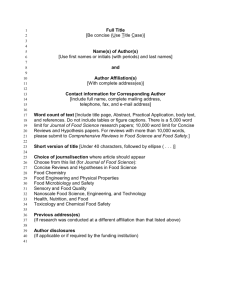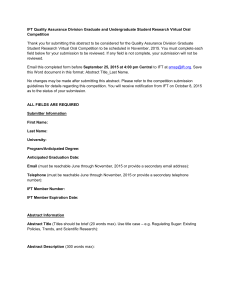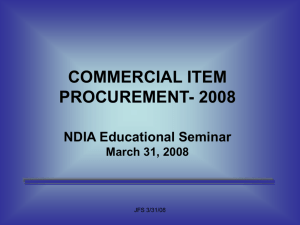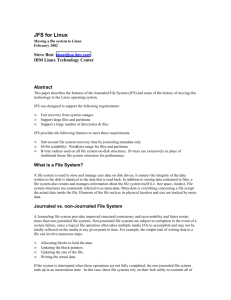Manuscript Template - Institute of Food Technologists
advertisement
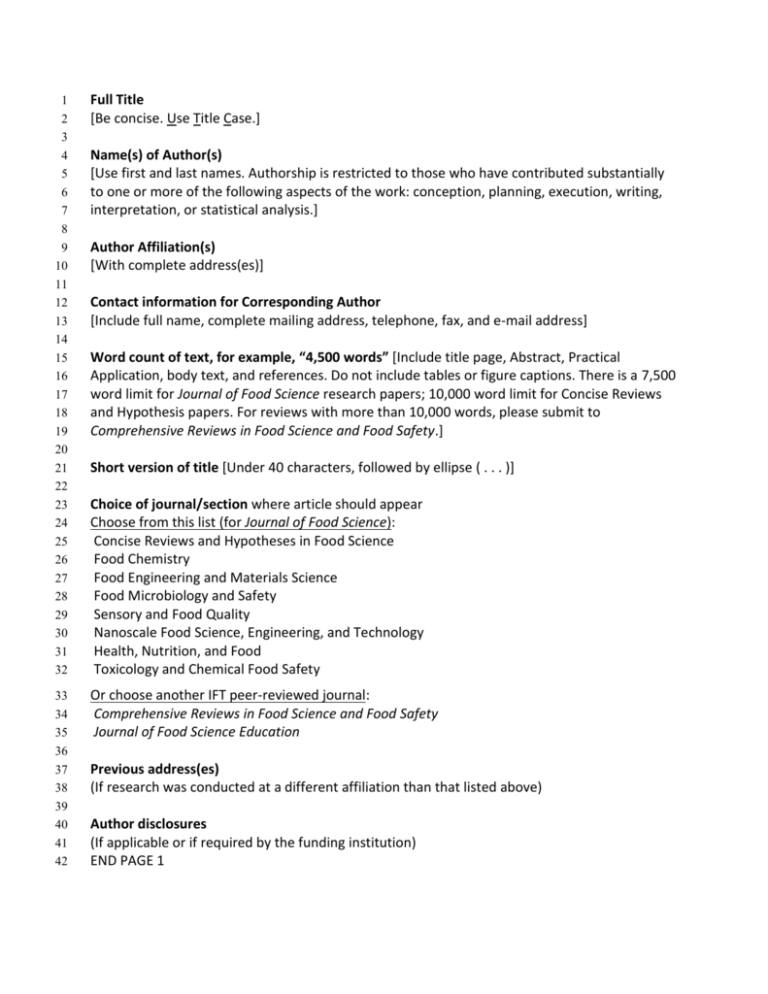
1 2 3 4 5 6 7 8 9 10 11 12 13 14 15 16 17 18 19 20 21 22 23 24 25 26 27 28 29 30 31 32 Full Title [Be concise. Use Title Case.] 33 34 35 36 37 38 39 40 41 42 Or choose another IFT peer-reviewed journal: Comprehensive Reviews in Food Science and Food Safety Journal of Food Science Education Name(s) of Author(s) [Use first and last names. Authorship is restricted to those who have contributed substantially to one or more of the following aspects of the work: conception, planning, execution, writing, interpretation, or statistical analysis.] Author Affiliation(s) [With complete address(es)] Contact information for Corresponding Author [Include full name, complete mailing address, telephone, fax, and e-mail address] Word count of text, for example, “4,500 words” [Include title page, Abstract, Practical Application, body text, and references. Do not include tables or figure captions. There is a 7,500 word limit for Journal of Food Science research papers; 10,000 word limit for Concise Reviews and Hypothesis papers. For reviews with more than 10,000 words, please submit to Comprehensive Reviews in Food Science and Food Safety.] Short version of title [Under 40 characters, followed by ellipse ( . . . )] Choice of journal/section where article should appear Choose from this list (for Journal of Food Science): Concise Reviews and Hypotheses in Food Science Food Chemistry Food Engineering and Materials Science Food Microbiology and Safety Sensory and Food Quality Nanoscale Food Science, Engineering, and Technology Health, Nutrition, and Food Toxicology and Chemical Food Safety Previous address(es) (If research was conducted at a different affiliation than that listed above) Author disclosures (If applicable or if required by the funding institution) END PAGE 1 43 ABSTRACT: State what was done (giving indication of importance), how it was done, major 44 results, and conclusions in 250 words or less (if abstract is longer than 250 words, you will be 45 asked to re-write it). Define all acronyms and abbreviations; do not cite references 46 47 Keywords: Include 5 keywords (no acronyms) for indexing purposes (don’t leave out the 48 obvious ones). Use of keywords from the submission form in ScholarOne is highly 49 recommended, for consistency across the journal and for improved search functionality in the 50 online publication. 51 52 Practical Application: (optional; recommended for JFS papers on original research) 53 In 2 to 3 sentences (under 100 words) written in plain laymen’s terms, state the possible 54 industrial or consumer application(s) of this research. This brief paragraph should be easily 55 understood by non-scientists and should not make extravagant claims. 56 *NOTE* Do not include a PA for JFS Concise Reviews, JFSE, and CRFSFS papers. 57 END PAGE 2 58 Introduction 59 In about 2 pages or less (double spaced), review pertinent work, cite key references, explain the 60 importance of the research, and state the objectives of your work. 61 Citation examples: 62 “Stalmach (2012) noted…” 63 “…on tomatoes (Zhang and others 2013).” 64 65 Materials and Methods 66 *NOTE* JFS Concise Reviews, JFSE, and CRFSFS papers do not have to follow the “Materials and Methods” and 67 “Results and Discussion” structured format. 68 Provide sufficient detail so work can be repeated. Use subheads for clarity. Avoid use of trade 69 names. Define abbreviations and acronyms. 70 Conduct statistical analysis only if variation with a treatment (standard deviation divided by the 71 means) is greater than 10% and difference among treatment means is less than 3 standard 72 deviations. 73 Be careful not to commit self-plagiarism by using exact wording from a previous publication. 74 75 Results and Discussion 76 Present and discuss results concisely, using figures and tables as needed (but not the same 77 information in both figures and tables). Compare results to those previously reported, and 78 indicate what new information is contributed herein. Place figures and tables at the end of the 79 document, after references. 80 81 Conclusion 82 State conclusions (do not summarize) briefly. 83 84 Acknowledgments 85 List sources of financial or material support and the names of significant contributors (not 86 authors). 87 88 Author Contributions 89 List each author’s name and primary contribution(s) to this work. For example, “B. Yu designed 90 the study and interpreted the results. L. Smith collected test data and drafted the manuscript.” 91 Ghost, guest, honorary, or anonymous authorship is not allowed. Contributors who do not 92 qualify for authorship should be mentioned in the acknowledgments. 93 94 Nomenclature or Appendix 95 Not usually needed; can be included if necessary. 96 97 References 98 List only those references cited in the text (be sure references list all text citations), in 99 alphabetical order by the first author’s last name. Single author precedes same author with co- 100 authors. When the authors are identical in multiple references, sequence them by publication 101 date (earliest to latest); if authors and publication year are identical, differentiate them with 102 lowercase letters (2010a, 2010b). Type references flush left as separate paragraphs. Two 103 common examples are below; refer to the journal’s “Author Guidelines” for required format of 104 references, and to recently-published JFS or CRFSFS papers for additional examples. 105 Journal article: 106 Zhang L, Barrett DM, McCarthy MJ. 2013. Characterization of the red layer and pericarp of 107 processing tomato using magnetic resonance imaging. J Food Sci 78(1):E50-5. doi: 108 10.1111/j.1750-3841.2012.03007.x 109 (Note: issue number is optional; provide the DOI if known, especially if the article is in press or online-only) 110 Book: 111 Stalmach A. 2012. Bioavailability of coffee chlorogenic acids. In: Chu YF, editor. Coffee: 112 Emerging health effects and disease prevention. Ames, IA: Wiley-Blackwell. p 59-76. 113 114 Tables 115 Number each table with Arabic numerals, and place a descriptive caption at the top. Include 116 one table per page. Use plain text with tabs and returns—do not embed tables from other 117 programs. Identify footnotes with lower-case letters appearing as superscripts. Alternately, 118 upload table files (in editable format such as Excel or Word) separately after the main body text 119 file in your submission. 120 121 Figures (graphs, charts, line drawings, photographs) 122 Use one illustration per page, with the figure number and caption below each figure. Use Arabic 123 numerals. See “IFT Scientific Journals- Style Guide for Graphics” for graphics specifications. 124 Authors are responsible for obtaining copyright permission to reproduce copyrighted 125 illustrations. Alternately, upload figure files (in high- resolution TIFF, EPS, or press-quality PDF 126 format) separately after the main body text file in your submission. 127 128 Supplemental Information 129 Not usually needed. If you have very large tables, data sets, videos, or other supplementary 130 material that is too large to publish in print or in a format not amenable to print, it can be 131 published in the online version, attached to the paper in the table of contents. Submit 132 supplementary materials as separate files and note at the end of the main body text that those 133 files should be published online as such. 134 135 136 137 138 Additional Author Resources: 139 140 141 142 143 144 145 146 147 148 149 150 Several language translation and editing services exist to help non-native English speakers prior to submission, such as Wiley Editing Services (http://wileyeditingservices.com/en) and American Journal Experts (http://www.journalexperts.com) 151 You are expected to adhere to publication ethics standards. For reference, see Wiley’s “Best Practice Guidelines on Publishing Ethics: A Publisher’s Perspective. Second Edition” at http://exchanges.wiley.com/ethicsguidelines 152 153 View the Author Guidelines, Journal Aim & Scope, Supplementary Instructions for Special Topics, and other author materials at http://www.ift.org/AuthorsCorner Additional author resources are available through Wiley-Blackwell Author Services at http://authorservices.wiley.com/bauthor/author.asp If you do not have a subscription to JFS but would like to see recent examples of published articles, go to the JFS homepage (http://onlinelibrary.wiley.com/journal/10.1111/(ISSN)17503841) and open the latest January issue, which is opened as a free sample issue each year. You may also view all Concise Reviews and Hypothesis and other select articles for free.
